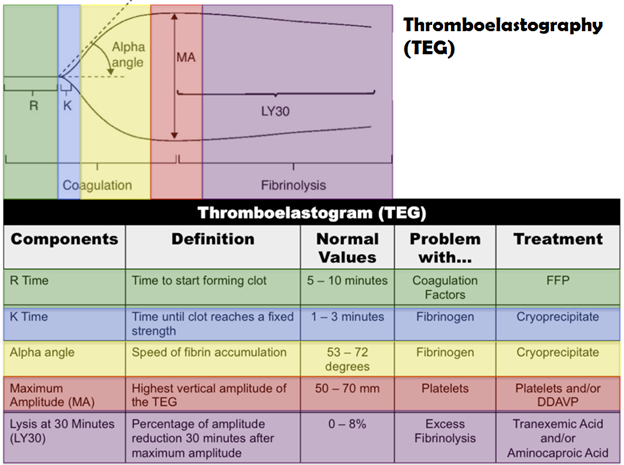1/n Everybody seems to be very opinionated about thromboelastography! Here is how I view it and what I use it for…….
2/13 2/n TEG is a point of care test that measure the tensile strength of blood clot formation. As the clot forms there is resistance and this is translated into a curve
3/13 So what do all these letters stand for? R = reaction time and is the time from initiation of coagulation until a thrombus starts forming. Kinda like a PTT or any clotting time. So will be up in hemophilia, coagulation deficiency etc…
4/13 The alpha angle is the rate of thrombin generation and resultant conversion of fibrinogen to fibrin. Dependent on fibrinogen mostly with some platelet contribution. Also reflected in k time
5/13 The maximal amplitude (MA) is mainly a function of platelets with some contribution from fibrinogen. Decreased with thrombocytopenia and low fibrinogen.
6/13 My favorite – the LY30 – a measure of fibrinolysis – can be increased in hyperfibrinolytic states and low where there is fibrinolytic shutdown (seen often in COVID patients)
7/13 So what do I mainly look at?
7.5/13
R time: assessing coagulopathy, anticoag effect, shorterned r times suggestive of hypercoag
MA: clot strength – low I check platelets and fibrinogen, elevated concerned with hypercoag
LY30: increased need to act on fibrinolysis, again low suggestive of hypercoag
R time: assessing coagulopathy, anticoag effect, shorterned r times suggestive of hypercoag
MA: clot strength – low I check platelets and fibrinogen, elevated concerned with hypercoag
LY30: increased need to act on fibrinolysis, again low suggestive of hypercoag
8/13 TEG based interventions:
High R time: FFP, factor concentrates, anticoagulation reversal
Low MA: platelet transfusion, cryoprecipiate (fibrinogen)
LY30: tranexamic acid
High R time: FFP, factor concentrates, anticoagulation reversal
Low MA: platelet transfusion, cryoprecipiate (fibrinogen)
LY30: tranexamic acid
10/13 Where do I find it helpful? Liver disease is the biggest - routine tests such as the INR are worthless. TEG is a much better reflection of hemostasis. My record is a patient with an INR of 3.76 with a stone cold normal TEG. Use of TEG prevents overuse of plasma
11/13 Lots of trauma use – can often obtain TEGs faster and again may lead to better product use. Have seen a few patients with “hyperfibrinolysis” who benefit from more TXA. Good data in the cardiac surgery setting of better outcomes
12/13 so to me I found the TEG an useful adjunct to other labs and the clinical picture. Really helpful to cut product use esp FFP in liver disease.

 Read on Twitter
Read on Twitter








